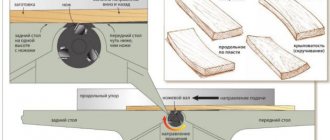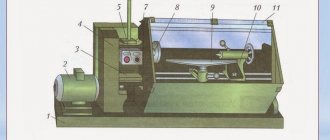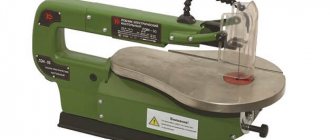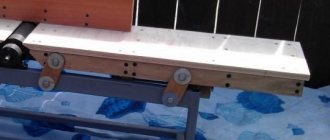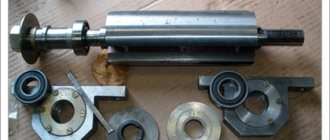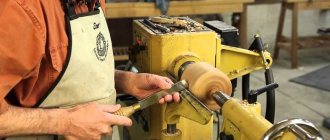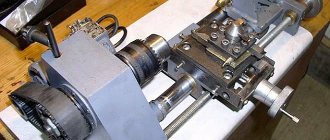Very often there is a need to make an exact copy of a certain part from various materials. In production conditions, a special copying machine for wood and metal is used for this. This type of device is very easy to make yourself using simple materials. The advantage of such a copy-milling machine is its high productivity. If you do everything correctly in a short period of time, you can get a lot of high-quality parts that will be no different from the original sample.
General description of the equipment
The purpose of wood copying and milling machines is to process various parts both in volume and in plane. Their operating principle is somewhat similar to CNC units. If wood samples are processed, then using milling machines of this type the following can be achieved:
- reproduce any ornaments;
- apply the desired inscription to the surface of the workpiece;
- engrave shaped profiles;
- obtain complex volumetric workpieces with multiple small parts that are placed in different planes.
Processing parts on a machine
A milling and copying unit that works with wooden parts is most often used for furniture production.
It helps to create all the necessary decorative elements, which is difficult to achieve in any other way.
Features of the unit
A milling machine for metal or wood works using the following rules:
- The cutting element in this type of equipment is a milling cutter. It creates the desired contour or volumetric elements in accordance with the established software specifications;
- There is another connecting element between the cutting element and the tracking device. This is a supply and control system, which can be mechanical (used in the simplest units that process wood), hydraulic or pneumatic;
- As a copier, a specially created template, outline drawing or a ready-made part is mainly used. CNC copy-milling machines do not require such samples, so they are considered universal. These units operate thanks to numerical commands that are specified by the user through a special interface.
- templates can be blanks made from any materials - wood, metal, plastic, etc.
Design features of the machine
In order to understand how to make a copy-milling machine for wood, you should become more familiar with its design features. Such installations are designed for processing profiles or reliefs of products using a carbide cutting tool called a milling cutter. It forms a contour or repeats the surface of the master unit - the copier. It has a mechanical, pneumatic or hydraulic connection with a tracking system responsible for guiding the cutting part.
On the one hand, the effect is on the amplification device, while on the other, on the executive body. When making a copy-milling machine for wood, you can use a flat template, a reference part, or a spatial model as a copier.
The copying device will be a probe, finger, copy roller or photocell. You can make samples for copying from different materials, namely:
- wood;
- plastics;
- metal
When manufacturing a copy-milling machine for wood, the copier and the workpiece are fixed on a rotating table. As for the executive body, it is a differential, electromagnetic clutch, solenoid, screw or spool. If we are talking about a machine with an amplifying device, then the design involves the use of hydraulic, electromagnetic or electro-optical relays.
The accuracy of the profile and the surface roughness of the product will depend on the speed of movement of the tracking unit. The actuator circuit is driven by an electric motor and a hydraulic power cylinder. A wood copying and milling machine will have a pantograph, which is a special device that ensures copying at a specified scale.
If you plan to manufacture the machine yourself, then this unit can be included in the design. It has a guide pin located on the axis. Its movement is directed towards the copier. As the finger moves, the spindle describes a similar geometric figure on the workpiece. The copying scale will be determined by the proportions of the pantograph arms.
Types of milling machines with copying function
Copying machines can have different drives. On this basis, this equipment is divided into:
- units where a pantograph is present. Allows you to copy at the desired scale. The equipment where the pantograph is installed can process parts in several directions. The design of this unit includes a spindle pin and an axis of rotation. The pantograph provides the required scale of processing due to a certain ratio of distances between these elements;
- copiers that are equipped with a working mechanism mounted on a rotary rack;
- devices with single or multiple spindles that have rotary tables of various sizes and shapes;
- units with different supply schemes - mechanical, hydraulic, electrical;
- photocopying installations.
Depending on the degree of automation of all operations and the method of fixation, this equipment can be:
- desktop, where the workpiece is secured mechanically;
- stationary, where parts are fixed using pneumatic clamps;
- stationary with pneumatic clamps and a three-spindle head.
Do-it-yourself copying machine for a router
Safety regulations
Since the tool is both electric and cutting, it requires careful operation and compliance with basic safety rules.
Safety guidelines include:
The device should be placed indoors in such a way that it is easily accessible.- The room itself should be well ventilated.
- Before turning it on, you need to make sure that the table surface is free of unnecessary objects and nothing interferes with the operation of the device.
- All fasteners, especially the cutter, must be securely fastened and not loose.
- The electric motor must be grounded and not damaged.
- Do not touch rotating shafts with your hands until they come to a complete stop.
- Any repair work is carried out only with the device turned off and the engine disconnected from the mains.
- You need to stand on a rubber mat while working.
- After half an hour of continuous operation, it is necessary to turn off the machine and allow the parts to cool.
Knowing and following simple safety precautions prevents injuries, cuts, bruises, and sometimes saves lives.
Homemade machine design
A DIY wood milling machine will consist of the following structural elements:
- work surface that fits in size;
- a supporting frame that will ensure the stability of the unit during operation;
- unit required for installing cutters.
When making this homemade product, you need to take into account that the milling head used must be equipped with a transmission mechanism, which must have an electric motor. This will provide the unit with several operating modes at different speeds.
Milling head
Specifications
Each model has its own specific numbers for parameters. The following technical characteristics are important for models of any type:
- Weight.
- Electric motor power and speed.
- Maximum vertical movement of the table.
- Transverse movement of the table.
- Longitudinal travel of the table.
- Determining the dimensions of the working surface of the table.
- The working surface of the table of the product that is being copied.
- Diameter of the largest circle.
- Copy scale.
The machines are equipped with additional tools that help create various shapes. Using templates makes your work easier.
Some tips for making a machine yourself
A homemade copying machine does not have precise control, which leads to a decrease in the quality of parts made with its help. All the shortcomings are especially pronounced when changing the direction of the cutter or during active operation of the unit, which is accompanied by vibration in the entire plane of the structure. It is almost impossible to eliminate these defects. Therefore, it is recommended to create narrow-profile units that are aimed at processing only certain parts.
Also, during the manufacture of a homemade copying machine, you should pay attention to the weight and dimensions of the parts being processed. The larger they are, the more massive the supporting frame of the equipment should be. This will absorb all the resulting vibrations and provide a sufficient margin of safety, which will make the machine you created with your own hands durable and reliable.
To ensure high quality processing of wood parts, care should be taken to ensure sufficient engine power. If it is 150-220 W, then ensuring the required rotation speed of the cutter will not be difficult.
It is also necessary to remember that the assembly that connects the cutter to the copying probe must be strong and reliable. It is very important that their plane and the surface of the desktop completely coincide. As a result, the created structure is rigidly installed on the supporting frame. It should also move freely along the working surface in all necessary directions.
Using these tips, it is very easy to create a copying machine yourself. But we should not forget that its scope is limited. If you need to process parts of different types and sizes, it is better to purchase universal equipment that is manufactured in a factory.
Examples of manufacturers
Those who need a reliable machine for flat milling should pay attention to the products of the Italian company GRIGGIO. Machines of this brand have a relatively low price and are a good solution for creating shaped parts, skirting boards, and trims. With their help it is convenient to create facades of furniture panels and wooden doors.
The VFK-810 milling machine with a table rotation angle of 45 degrees is perfect for those who are interested in making furniture. Its distinctive feature is the high speed of rotation of the cutter (up to 20,000 rpm), which guarantees excellent surface quality of the finished product.
The Chinese MX 5068 unit has comparable characteristics at a much lower price. It boasts a cutter rotation speed of up to 18,000 rpm and uses a pneumatic drive for table rotation and tool movement.
Those who are planning to take up carpentry seriously should pay attention to a milling unit made in Taiwan. WINNER LH-1000 will be the best assistant when it is necessary to mass produce similar parts. A special feature of the machine is a multi-level spindle, which allows you to perform several operations at once in one pass and create a product of the required profile without the need to rearrange the cutting tool.

